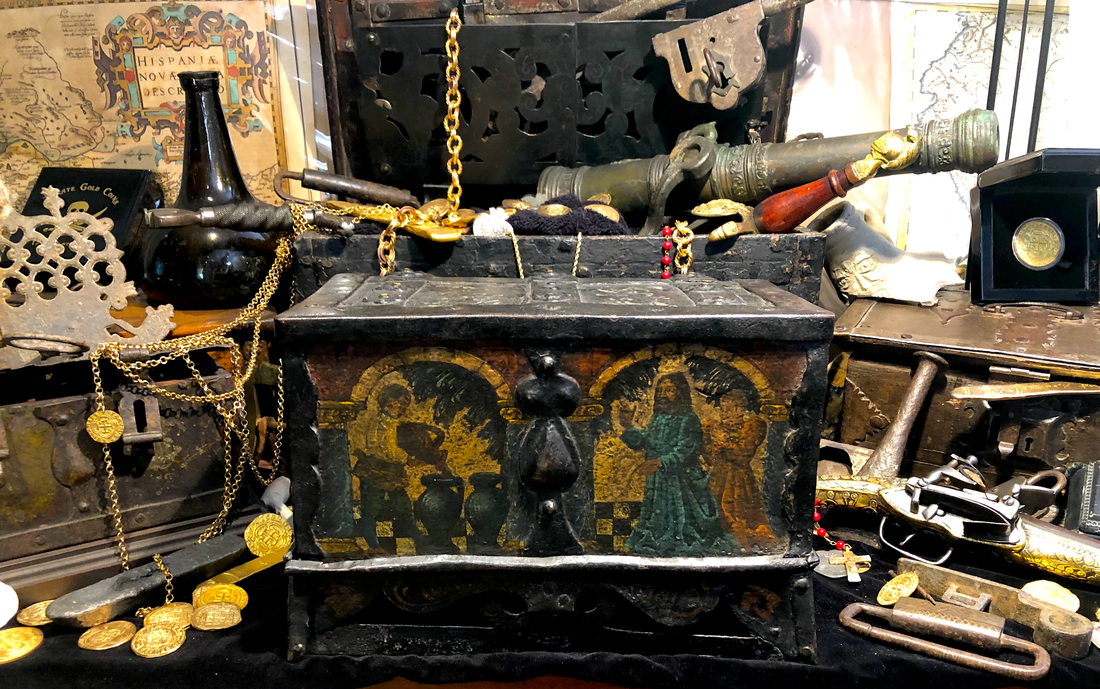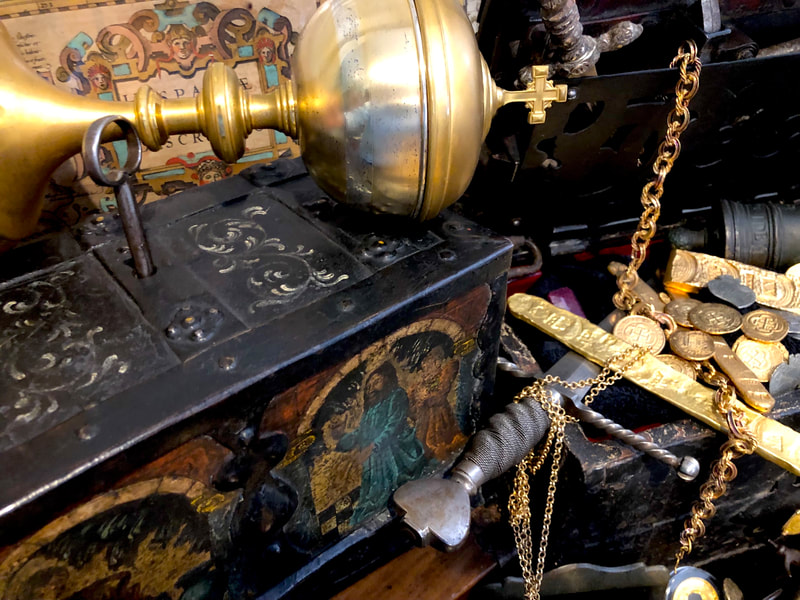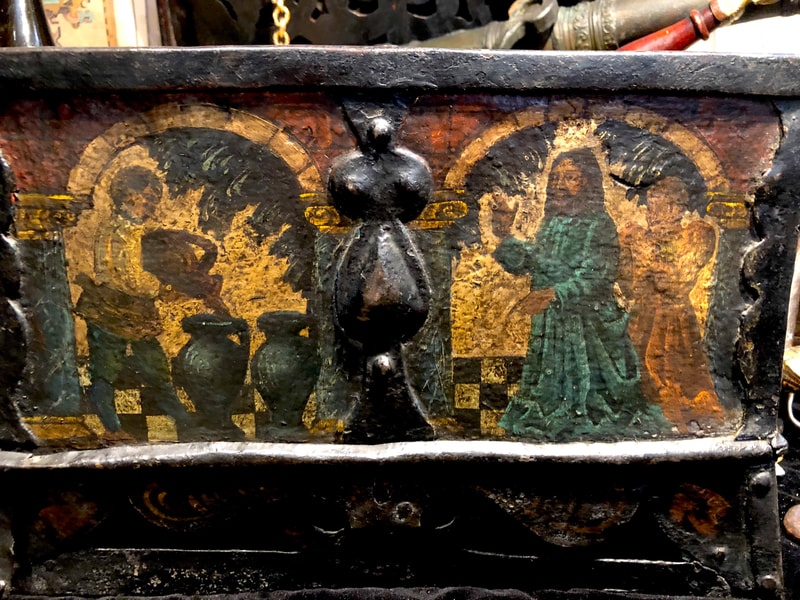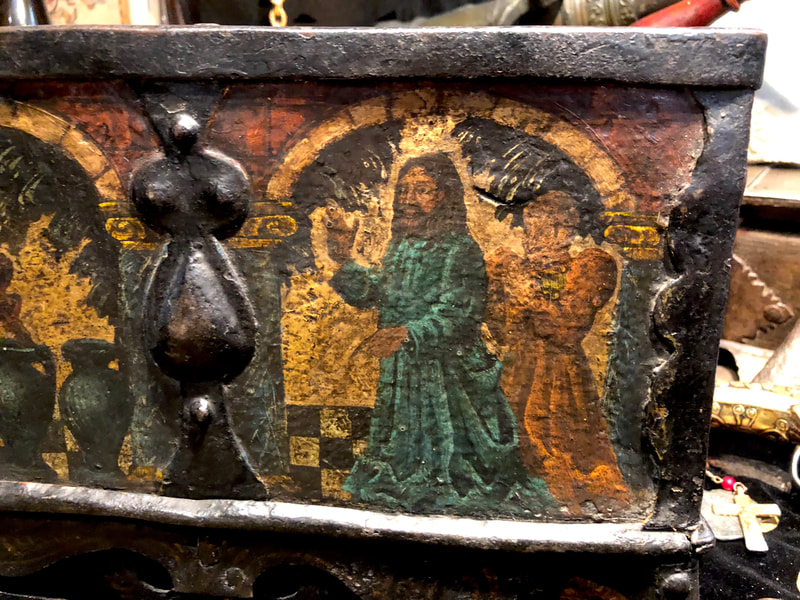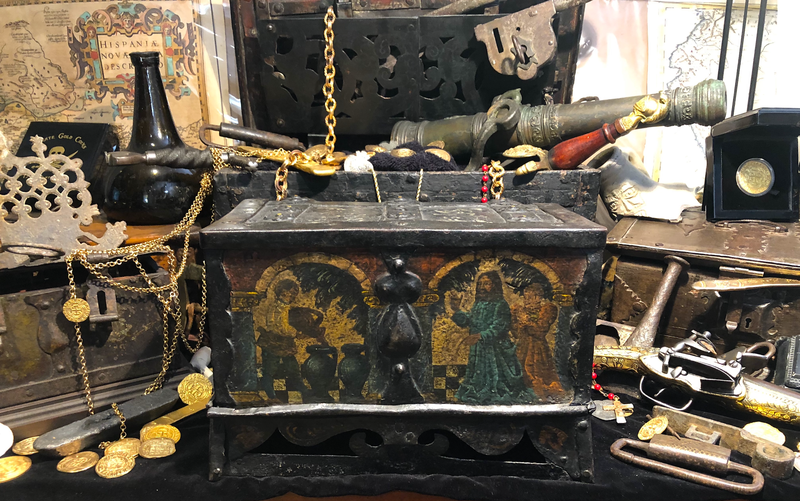Armada Chest "Jesus Christ" 1600's Nuremberg Pirate Gold Coins Treasure Chest
TREASURE ARMADA "JESUS" CHEST NUREMBERG PIRATE GOLD COINS SHIPWRECK ATOCHA ERA
This ARMADA CHEST & Key were hand forged in Nuremberg Germany weighs approx. 7.5 lbs and measures 11.5” W x 8” H x 6.5"D base (Chest alone 5" D) in Cm = 29cmWx 20cmH x 18cmD . Beautifully Painted (during the Rennisance period) in Period (at time of forging) featuring two panels on the front with "JESUS" on the right side with Winged Angel behind him ~ Facing the Left panel of Priest pouring wine into Vases. This incredibly Artistic Painter was most likely commissioned by the CHURCH to represent the Church for it's rituals. Very feasibly this Nurmemberg Chest was used to Secure the Church's valuables ~ very possibly a Golden Chalice (as used in Catholic Churches to pour their wine into (the Blood of Christ) for the Priests to drink from. The Artist also pained various Scrolls and Floral Vignettes throughout. It also has been engraved / struck on the inside lid ~ escutcheon plate with an Ornate Scroll and intricately Engraved designs. Also Discovered on the inside of the Chest is the remnants of what appears to be Parchment paper adheared to the inside of the Chest with looks to be "Quill Pen" writing of perhaps an inventory of the contents and values. The front “Lock Plate” is a False Lock! Inside the lids are the Locking mechanisms – full 6 Pin Locking Bolts, in 3 directions. This particular Treasure Chest has a Master CHEST Key. These Treasure Chests, in general were used to carry: Pirate Booty, Soldier wages, Precious Jewels of Royalty, Tariffs, Royal Taxes, Gold & Silver Coins and Bars! Built by the same blacksmiths that created Arms and Armory. Struck and forged, these CHESTS were in the 1500 and 1600’s ~ Out of Sheet iron with reinforced intersecting straps and fittings of Iron. These highly skilled Blacksmiths worked in Germany, Austria and France. These Master Blacksmiths, from the late 1400’s, were renowned for their craftsmanship, especially in Germany, Austria and Switzerland. These shops were usually old family businesses in which younger generations were trained by their elders. These highly skilled Blacksmiths excelled in Metalworking, hammered inlay, etching, steel plating engraving, Painting and of course rust proofing. By the dawn of the Renaissance they had achieved a dominant position in Europe. The Blacksmiths and their skills were in high demand throughout Europe and beyond.
This ARMADA CHEST & Key were hand forged in Nuremberg Germany weighs approx. 7.5 lbs and measures 11.5” W x 8” H x 6.5"D base (Chest alone 5" D) in Cm = 29cmWx 20cmH x 18cmD . Beautifully Painted (during the Rennisance period) in Period (at time of forging) featuring two panels on the front with "JESUS" on the right side with Winged Angel behind him ~ Facing the Left panel of Priest pouring wine into Vases. This incredibly Artistic Painter was most likely commissioned by the CHURCH to represent the Church for it's rituals. Very feasibly this Nurmemberg Chest was used to Secure the Church's valuables ~ very possibly a Golden Chalice (as used in Catholic Churches to pour their wine into (the Blood of Christ) for the Priests to drink from. The Artist also pained various Scrolls and Floral Vignettes throughout. It also has been engraved / struck on the inside lid ~ escutcheon plate with an Ornate Scroll and intricately Engraved designs. Also Discovered on the inside of the Chest is the remnants of what appears to be Parchment paper adheared to the inside of the Chest with looks to be "Quill Pen" writing of perhaps an inventory of the contents and values. The front “Lock Plate” is a False Lock! Inside the lids are the Locking mechanisms – full 6 Pin Locking Bolts, in 3 directions. This particular Treasure Chest has a Master CHEST Key. These Treasure Chests, in general were used to carry: Pirate Booty, Soldier wages, Precious Jewels of Royalty, Tariffs, Royal Taxes, Gold & Silver Coins and Bars! Built by the same blacksmiths that created Arms and Armory. Struck and forged, these CHESTS were in the 1500 and 1600’s ~ Out of Sheet iron with reinforced intersecting straps and fittings of Iron. These highly skilled Blacksmiths worked in Germany, Austria and France. These Master Blacksmiths, from the late 1400’s, were renowned for their craftsmanship, especially in Germany, Austria and Switzerland. These shops were usually old family businesses in which younger generations were trained by their elders. These highly skilled Blacksmiths excelled in Metalworking, hammered inlay, etching, steel plating engraving, Painting and of course rust proofing. By the dawn of the Renaissance they had achieved a dominant position in Europe. The Blacksmiths and their skills were in high demand throughout Europe and beyond.

